Sure, the best protein powders can help you reach your protein goal for the day, but when you get hungry between lunch and dinner, you’ve probably pulled open the refrigerator and peered in, looking for a snack high in protein to keep you going. Having some snack options on hand can help you stick to your goals, and high-protein options will help you stay satisfied — and muscular.
Choosing healthy snacks that are high in protein can also help you hit your protein intake goals. Getting enough protein is essential when you’re aiming to gain muscle, recover from workouts, strengthen your bones, and even lose body fat. (1) Here are the 14 best healthy high-protein snacks so you can be prepared when the cravings hit.
The 14 Best High-Protein Snacks of 2024
Hungry between meals? These are the 14 best healthy snacks made up of high-protein foods and their macronutrient info. They’re quick, nutrient-dense, and you can take them on the go.
All nutritional information comes from the FoodData Central page on the United States Department of Agriculture (USDA) website. (2)
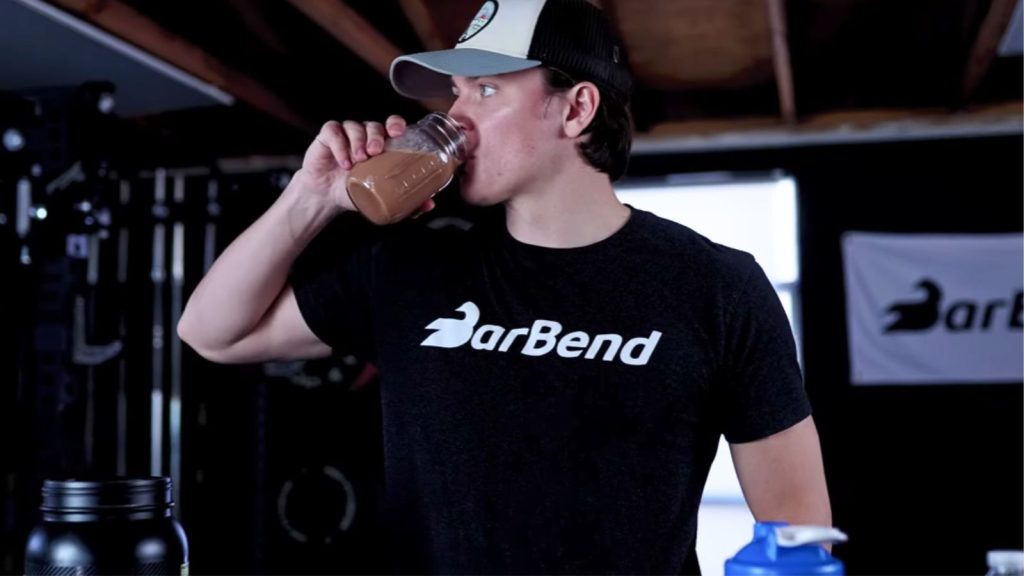
- Greek Yogurt
- Cottage Cheese
- Hard-Boiled Eggs
- Deli Meat Roll-Up
- Beef Jerky
- Edamame
- Quinoa
- Hummus
- Homemade Trail Mix
- Protein Shake
- Peanut Butter Celery Sticks
- Canned Tuna or Salmon
- Protein Bars
- Almonds
Greek Yogurt
Yogurt has always been a popular snack for people looking for something low in calories. Greek yogurt can be an even better option because it’s a high-protein food and will keep you fuller for longer. It’s also a great source of calcium, and you can get a non-dairy version if you don’t eat dairy.
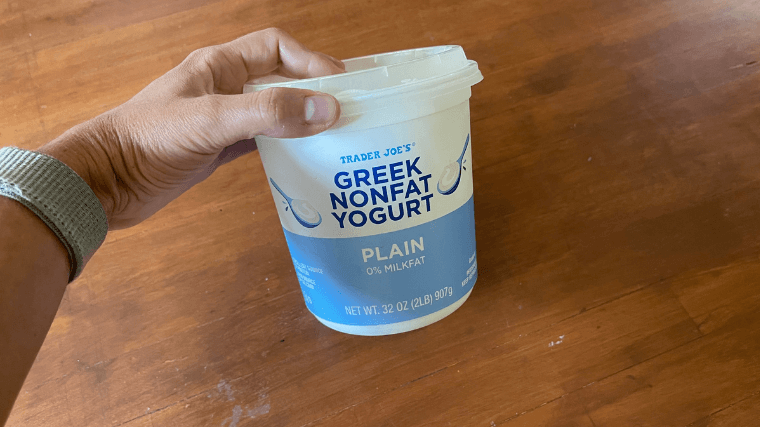
For extra flavor, add a handful of blueberries to get some antioxidants. You may also want to add nut butter for healthy fats or granola for a crunch. Top with chia seeds, hemp seeds, or pumpkin seeds for an extra protein boost.
One 200-gram serving of low-fat Greek yogurt packs 20 grams of protein, 3.8 grams of fat, and 7.9 grams of carbs. Toppings will increase the calories, but they’ll help keep you satisfied.
Cottage Cheese
Cottage cheese is another dairy option that’s high in calcium and packed with protein. It’s recently become popular on social media because it’s so versatile, and you can add it to recipes to boost the protein content.
To keep it quick and simple, you can have it on its own, add some blueberries, or pair it with an apple, pineapple, watermelon, tomato… the list goes on. We’d also recommend tossing a scoop into a blender — once the consistency is smooth, add it to mac and cheese for a creamier, protein-packed nibble.
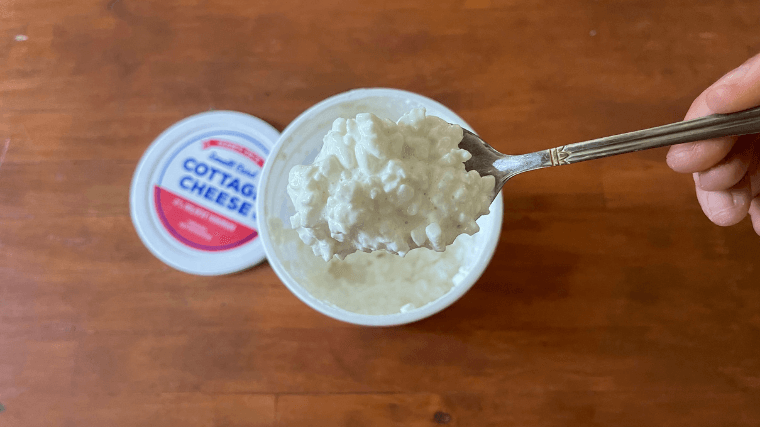
[Read More: Best Tasting Protein Powders, Tested and Reviewed by Our Team]
If you’re a dip fiend, blend a scoop or two of cottage cheese in a blender until the consistency is smooth and creamy. Then mix in some ranch seasoning. Let it sit in the fridge for about an hour to let the flavor take hold, and then you’ve got a high-protein ranch dip for your baby carrots, chips, or cut-up pepper.
A 113-gram serving of low-fat cottage cheese has 14 grams of protein, 1 gram of fat, and 3 grams of carbs.
Hard-Boiled Eggs
Hard-boiled eggs are a super easy addition to your meal prep plans. Eggs contain many nutrients, including B vitamins. And if you only like egg whites, removing the yolk is easy enough.
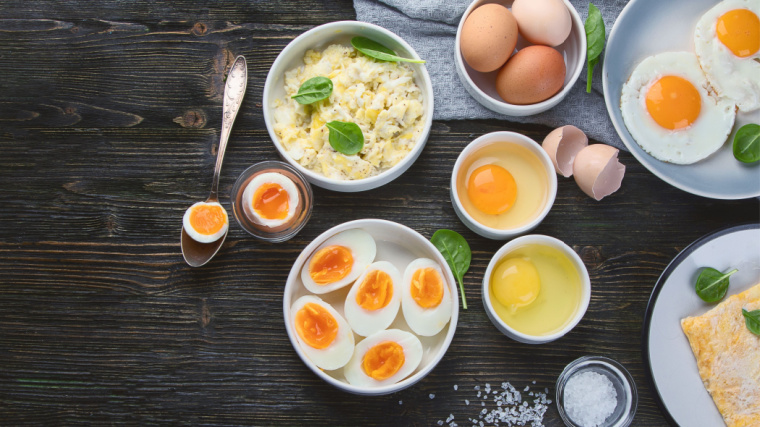
One large egg contains 6 grams of protein, 5 grams of fat, and 0.5 grams of carbs. One egg on its own isn’t a huge source of protein, so you may want to have two or three for a more filling snack.
Deli Meat Roll-Up
If you’re a carnivore, deli meat makes a satisfying snack. Sliced turkey breast is a healthy, high-protein choice. Grab a few slices, roll them up, and you’re good to go. You can also add in a string cheese for some extra protein. Turkey roll-ups are a low-carb option, but you can stuff your turkey and cheese in a whole-grain wrap to add healthy carbs.
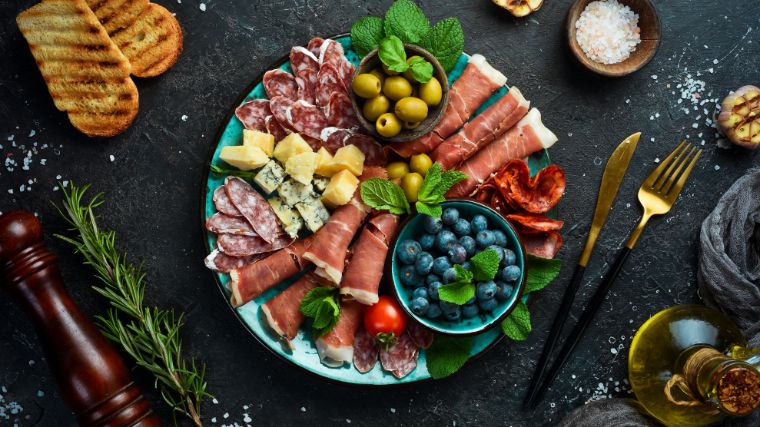
One slice of turkey breast has 6 grams of protein, 0.2 grams of fat, and 0.9 grams of carbs. Three slices will get you close to 20 grams and make you feel more satisfied. Adding in a low-fat string cheese will give you an extra 7 grams of protein, 5.7 grams of fat, and 1 gram of carbs.
Beef Jerky
Jerky is a super convenient and healthy — one of the best protein snacks for those who eat meat. It’s made from meat that has been processed and dried. Some brands have a ton of additives, so you may want to read the label and look for one with minimal ingredients. You can also make your own. You can easily find beef, turkey, salmon, or chicken jerky in most local bodegas or grocery stores.
A one-ounce serving of beef jerky contains 9.4 grams of protein, 7.4 grams of fat, and 3 grams of carbs.
Edamame
Edamame beans are a form of soybeans packed with protein and other nutrients, including vitamin K and folate. They’re a type of legumes, which are a good source of healthy carbs. You can make them quickly in the microwave, add some seasoning, and enjoy. Edamame is an excellent option for vegan athletes looking for a high-protein snack.
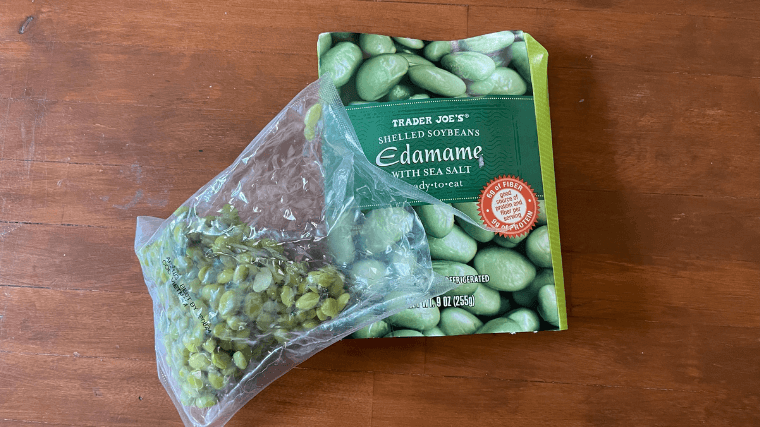
A 1-cup serving of edamame yields 18 grams of protein, 8 grams of fat, and 13.8 grams of carbs.
Quinoa
Quinoa is a good vegan protein source that’s a gluten-free whole-grain. It can be part of a healthy meal, but you can also make a quick cup for a filling snack. Add a little olive oil for some healthy fats.
A 1-cup serving of quinoa has 8.1 grams of protein, 3.5 grams of fat, and 39.4 grams of carbs. It also has 5 grams of fiber that will help keep you full.
Hummus
Hummus on its own isn’t the highest protein source, but it has other health benefits — and it’s easy to add other proteins to the mix. This popular spread is made from chickpeas, which are legumes that contain fiber and healthy fats that will fill you up.
Add string cheese to your snack for some extra protein on the side, or spread some hummus on your turkey roll-up. You can dip veggies in hummus to get some more nutrients as well.
A 100-gram serving of hummus contains 7.3 grams of protein, 17 grams of fat, and 15 grams of carbs. It also has 5.4 grams of fiber.
Homemade Trail Mix
Make your own trail mix for a delicious protein-rich snack to take on the go. You can choose ingredients with the highest protein content. We recommend almonds, pistachios, cashews, and pumpkin seeds — some of the best foods for energy — before, during, and after your training. Almonds contain antioxidants, pistachios are high in essential amino acids, and pumpkin seeds contain fiber. They all have healthy fats as well. You can also add dark chocolate or chocolate chips to your trail mix for more antioxidants.
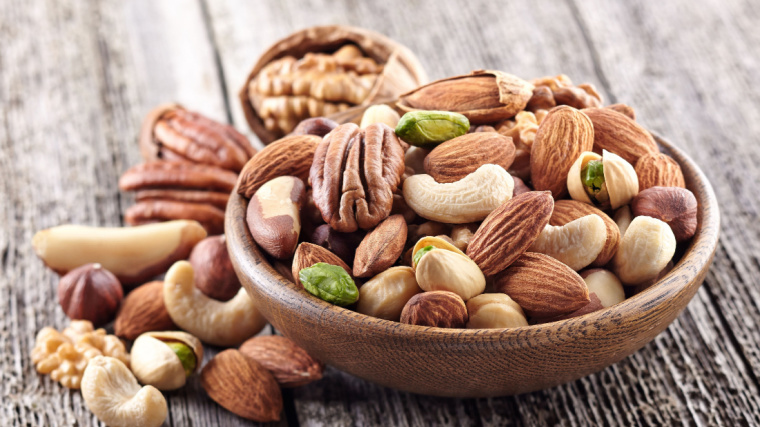
You probably won’t add a whole serving of each ingredient if you’re mixing a few of them, but here’s how they all break down:
- A 28-gram serving of almonds contains 6 grams of protein, 14 grams of fat, and 6.1 grams of carbs.
- A 30-gram serving of pistachios yields 6 grams of protein, 13 grams of fat, and 9 grams of carbs.
- A 28-gram serving of cashews has 4.3 grams of protein, 13 grams of fat, and 9.2 grams of carbs.
- A 28-gram serving of pumpkin seeds has 5.27 grams of protein, 5.5 grams of fat, 15.3 grams of carbs, and 5.2 grams of fiber.
Protein Shake
Dietitians recommend reaching your protein intake goals through whole foods before adding supplements, but the best protein shakes can also make for a satisfying snack. Depending on the flavor of your protein powder, you can mix it with water, milk, or a plant-based milk substitute. Add some peanut butter or almond butter for healthy fats, and throw in some blueberries or a banana for extra texture and nutrients.

Whey protein is a high-quality source of protein and is one of the best options for people who consume dairy. A one-scoop serving of whey protein packs 25 grams of protein, 0.5 grams of fat, and 2 grams of carbs.
Soy protein is a plant-based protein powder with similar benefits to whey if you don’t do dairy. One scoop typically yields 25 grams of protein, 2.5 grams of fat, and 13 grams of carbs.
There’s a lot of room for creativity with protein shakes, and you can add a variety of fruits, vegetables, and spices to one of the best-tasting protein powders to make yourself a smoothie that rivals any juice bar.
Peanut Butter Celery Sticks
The crunch of celery. The creaminess of peanut butter. If you need something to hold you over between meals, peanut butter celery sticks are rich in protein, fat, and fiber. This snack is relatively easy to make, too. After washing off your celery, spread peanut butter in the hollowed-out area, and boom, it’s snack time.
The key here is using a peanut butter with minimal ingredients, with peanuts being at the top of this list. (3) Some grocery markets even have grinders so you can make your own single-ingredient peanut butter in-store.
A serving of peanut butter is two tablespoons, which is typically around 188 calories, 16 grams of fat, 3 grams of saturated fat, 7 grams of carbohydrates, and 3 grams of fiber.
Two stalks of celery contain about 17 grams of calories, 4 grams of carbohydrates, 2 grams of fiber, and 0.9 grams of protein.
[Read More: Best Vegan Protein Powders, Tasted and Reviewed by a Dietitian]
Canned Tuna or Salmon
The chicken of the sea, the snack that made everyone say, “eww, what’s that smell” to me in middle school — canned tuna or salmon is a high-protein, low-calorie food that’s packed with Omega-3s.
A 4-ounce serving of canned tuna in water typically has 130 calories, 28 grams of protein, no carbs, and 0.9 grams of fat. Similarly, a 4-ounce serving of canned salmon in water typically contains around 155 calories, 23 grams of protein, no carbs, and 6 grams of fat.
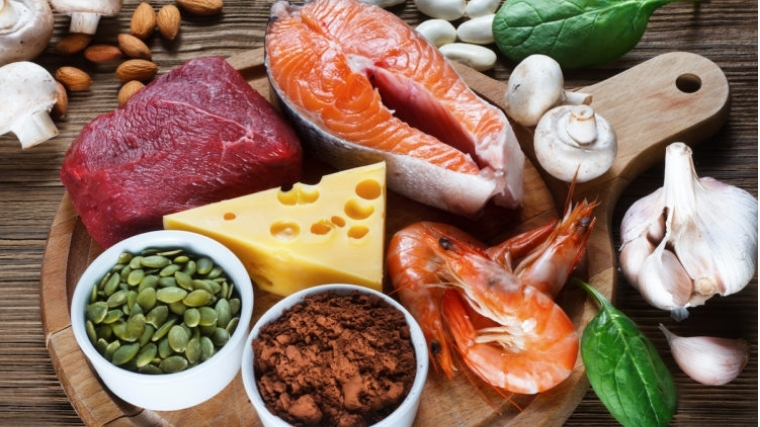
If you’re a lunatic or a cat, eat it straight from the can. We won’t judge you. If anything, we’re impressed with your will to fill your protein needs. However, if you’d rather relish your snack, add some chopped-up red onion and celery, a scoop of Greek yogurt as a mayo substitute, and some Dijon mustard, lemon juice, and black pepper for a low-calorie tuna or salmon salad. You can also consider tossing in some peas, pickles, relish, cucumber, and garlic.
Pro tip: chop up your red onion finely or marinate it in some vinegar to cut back on the intensity of its flavor.
Protein Bars
When you need a quick snack or maybe even a meal replacement, the best protein bars can satisfy your hunger with a spread of macronutrients to keep you moving.
You can make your own by mixing protein powder, peanut butter, almond or coconut flour, and chocolate chips together, then flattening your mixture into a lined pan and refrigerating before you cut it into bar shapes. There’s a lot of room for creativity with this style of homemade protein bar, and you can add maple syrup, oats, nuts, and more to customize your snack.
If you prefer to forego making your own, here are a few of our favorite ready-to-eat protein bars.
Transparent Labs Protein+ Bar
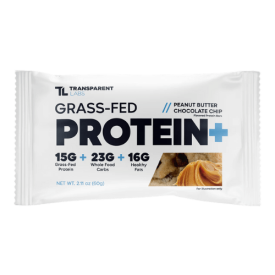
Among our favorite protein bars, the Transparent Labs Protein+ Bar packs plenty of protein per serving and uses only grass-fed whey, alongside other clean ingredients.
These 233-calorie bars provide balanced macros with 15 grams of protein, 23 grams of carbohydrates, and 16 grams of fats, and come in Peanut Butter Chocolate Chip, Dark Chocolate Almond, and Oatmeal Chocolate Chip flavors. “These bars genuinely taste like peanut butter and chocolate. The chocolate pieces melt in your mouth,” said our tester.
Onnit Protein Bites
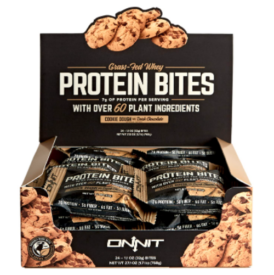
Onnit’s protein bites combine the decadence of a dark chocolate coating with a great tasting center, available in three delicious flavors — Chocolate Cookie Dough, Chocolate Coconut Cashew, and Chocolate Peanut Butter. These bites contain up to 9g of grass-fed whey isolate, and 7g of dietary fiber.
Gluten-free and tasty, these protein bars provide between 120 and 150 calories with 7 to 9 grams of protein per serving. Flavor offerings include Chocolate Coconut Cashew, Chocolate Cookie Dough, Cookies and Cream, and S’Mores. “The Cookies and Cream flavor is unbelievable. It tastes like a real Oreo cookie,” said our tester.
Almonds
A serving of almonds is 1 ounce, about a quarter of a cup (or 23 almonds). This snack is a calorie-dense food, with 165 calories per serving, 14 grams of fat, 6 grams of protein, 6 grams of carbohydrates, and 3 grams of fiber. (4) It can help satiate your hunger thanks to its fiber and macronutrients, and can potentially lower LDL cholesterol (the bad cholesterol). (5)
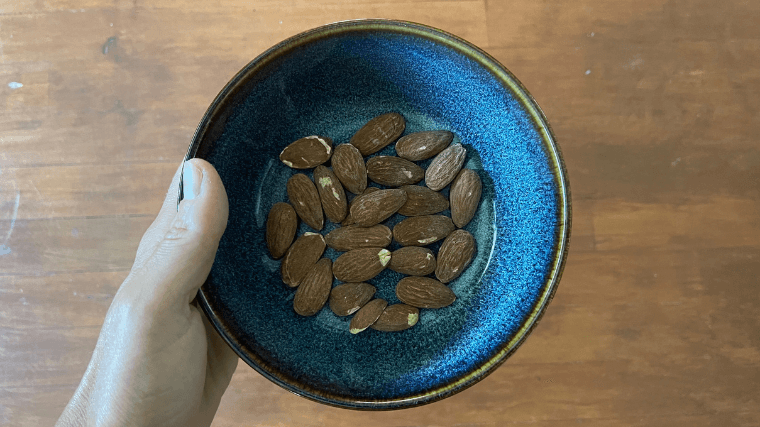
Almonds for snacking can be found raw, blanched, dry-roasted, and oil-roasted, as well as salted or unsalted. They’re often coated in flavorings like sweet Thai chili, vinegar, ranch, and dark chocolate. However, these flavorings can potentially raise the calorie, sodium, and sugar content.
How Much Protein Do You Need?
High-protein snacks can help fill the gaps in your day, but how much protein should you aim for? The Food and Drug Administration (FDA) states that adults need 50 grams of protein per day, but that’s the minimum requirement for bodily functions. (6)
For those trying to build muscle, The American College of Sports Medicine recommends 1.2 to 1.7 grams of protein per kilogram of body weight. (7) The International Society of Sports Nutrition, meanwhile, gives a range of 1.4 to 2.0 grams of protein per kilogram of body weight. (8) And some research shows that bodybuilders can benefit from having 2.3 to 3.1 grams of protein per kilogram of body weight per day. (9)
If you’re trying to lose weight while maintaining your muscle, the International Society of Sports suggests consuming 2.3 to 3.1 grams of protein per kilogram of body weight to lose fat and retain muscle. (10)
Try using our protein intake calculator to get your customized recommendation.
Snack Away
Protein is one of three macronutrients that your body needs to function properly. Aiming to hit your protein intake goals has many health benefits that can help you with your fitness goals of building muscle, losing body fat, and preserving bone health and strength as you age. (11)(12)
If you’re hungry, reaching for a healthy high-protein snack option will help keep you full and get you closer to reaching your intake goal. Choosing from whole foods like Greek yogurt, cottage cheese, eggs, meats, cheese, and legumes gives you plenty of healthy, high-protein snacks from which to choose. In a pinch, you can also whip up a protein shake with high-quality protein powder to chase those muscle gains.
References
- Wu G. (2016). Dietary protein intake and human health. Food & function, 7(3), 1251–1265. https://doi.org/10.1039/c5fo01530h
- USDA. FoodData Central. U.S. Department of Agriculture.
- Caudill, H., & Caudill, H. (2020, May 7). What to Look For When Buying Peanut Butter – Food & Nutrition Magazine. Food & Nutrition Magazine. https://foodandnutrition.org/blogs/student-scoop/look-buying-peanut-butter/
- Almonds. (2024, May 9). The Nutrition Source. https://nutritionsource.hsph.harvard.edu/food-features/almonds/
- Dikariyanto, V., Smith, L., Francis, L., Robertson, M., Kusaslan, E., O’Callaghan-Latham, M., Palanche, C., D’Annibale, M., Christodoulou, D., Basty, N., Whitcher, B., Shuaib, H., Charles-Edwards, G., Chowienczyk, P. J., Ellis, P. R., Berry, S. E. E., & Hall, W. L. (2020). Snacking on whole almonds for 6 weeks improves endothelial function and lowers LDL cholesterol but does not affect liver fat and other cardiometabolic risk factors in healthy adults: the ATTIS study, a randomized controlled trial. The American journal of clinical nutrition, 111(6), 1178–1189. https://doi.org/10.1093/ajcn/nqaa100
- USDA. Current dietary guidelines. Dietary Guidelines for Americans, 2020-2025.
- Rodriguez, N. R., DiMarco, N. M., Langley, S., American Dietetic Association, Dietitians of Canada, & American College of Sports Medicine: Nutrition and Athletic Performance (2009). Position of the American Dietetic Association, Dietitians of Canada, and the American College of Sports Medicine: Nutrition and athletic performance. Journal of the American Dietetic Association, 109(3), 509–527. https://doi.org/10.1016/j.jada.2009.01.005
- Jäger, R., Kerksick, C. M., Campbell, B. I., Cribb, P. J., Wells, S. D., Skwiat, T. M., Purpura, M., Ziegenfuss, T. N., Ferrando, A. A., Arent, S. M., Smith-Ryan, A. E., Stout, J. R., Arciero, P. J., Ormsbee, M. J., Taylor, L. W., Wilborn, C. D., Kalman, D. S., Kreider, R. B., Willoughby, D. S., Hoffman, J. R., … Antonio, J. (2017). International Society of Sports Nutrition Position Stand: protein and exercise. Journal of the International Society of Sports Nutrition, 14, 20. https://doi.org/10.1186/s12970-017-0177-8
- Helms, E. R., Aragon, A. A., & Fitschen, P. J. (2014). Evidence-based recommendations for natural bodybuilding contest preparation: nutrition and supplementation. Journal of the International Society of Sports Nutrition, 11, 20. https://doi.org/10.1186/1550-2783-11-20
- Jäger, R., Kerksick, C. M., Campbell, B. I., Cribb, P. J., Wells, S. D., Skwiat, T. M., Purpura, M., Ziegenfuss, T. N., Ferrando, A. A., Arent, S. M., Smith-Ryan, A. E., Stout, J. R., Arciero, P. J., Ormsbee, M. J., Taylor, L. W., Wilborn, C. D., Kalman, D. S., Kreider, R. B., Willoughby, D. S., Hoffman, J. R., … Antonio, J. (2017). International Society of Sports Nutrition Position Stand: protein and exercise. Journal of the International Society of Sports Nutrition, 14, 20. https://doi.org/10.1186/s12970-017-0177-8
- Bonjour J. P. (2005). Dietary protein: an essential nutrient for bone health. Journal of the American College of Nutrition, 24(6 Suppl), 526S–36S. https://doi.org/10.1080/07315724.2005.10719501
- Nunes, E. A., Colenso-Semple, L., McKellar, S. R., Yau, T., Ali, M. U., Fitzpatrick-Lewis, D., Sherifali, D., Gaudichon, C., Tomé, D., Atherton, P. J., Robles, M. C., Naranjo-Modad, S., Braun, M., Landi, F., & Phillips, S. M. (2022). Systematic review and meta-analysis of protein intake to support muscle mass and function in healthy adults. Journal of cachexia, sarcopenia and muscle, 13(2), 795–810. https://doi.org/10.1002/jcsm.12922